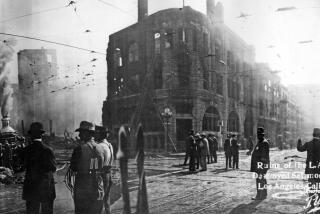Los Angeles Times reaches historic agreement with its newsroom union

The Los Angeles Times on Wednesday reached a tentative labor agreement with the guild that represents about 475 members of its newsroom, a milestone for a newspaper that for generations was known as a bastion of anti-unionism.
The two sides had been working on the newsroom’s first collective bargaining agreement for more than a year.
The proposed three-year agreement would provide immediate pay raises of at least 5% for many newsroom employees after years of stagnant wages, and some will see a more significant boost. The Times agreed to a 2.5% raise in the second and third years. The proposed contract includes job protections, parental leave, severance pay and rights for journalists who wanted to pursue book deals. In addition, managers of The Times committed to interview people from underrepresented groups to fill job openings as a way to increase newsroom diversity.
Most non-management newsroom employees will be covered, including reporters, columnists, data journalists, copy editors, librarians, web producers, audio producers, page designers, photographers and videographers.

“We’re really proud of what we’ve achieved together,” Carolina A. Miranda, co-chair of the L.A. Times Guild, said in a statement. “It’s a difficult time in the industry, but we’ve landed significant pay increases and a broad safety net of job protections that are some of the best in the industry. We’re grateful that Dr. Patrick Soon-Shiong is actively reinvesting in The Times. This is a win for journalism and a win for L.A.”
Members of the L.A. Times Guild, which is part of the NewsGuild sector of the Communications Workers of America, must ratify the agreement in a vote, which is expected to be scheduled by the end of the month. If ratified, the agreement would take effect in early November.
“My thanks to the union leadership and its members, as well as my colleagues in management, and Dr. Patrick Soon-Shiong for their dedication and professionalism through months of negotiations,” Times Executive Editor Norman Pearlstine said. “Initial contracts are inherently difficult to negotiate, with every article and clause having profound implications for both sides — now and in the future. With this agreement, I am convinced we have assured the revival of The Times under local ownership.”
After weeks of bargaining, with several marathon sessions that stretched well into the night, the two sides convened Wednesday evening in a conference room at The Times’ El Segundo headquarters to sign the tentative agreement. Nearly 40 people — guild members, top editors, executives and lawyers who advised the bargaining teams — gathered for the celebration.
“It’s been an honor and a privilege for us to help hammer out this deal, and we are looking forward to a great future,” Managing Editor Scott Kraft told the group.
When the final documents were signed, Miranda and L.A. Times Guild Co-Chair Anthony Pesce gave each other a high-five. The room burst into applause, cameras clicked and champagne soon flowed.
Support our journalism
The agreement continues a trend of increased union activity in publishing, an industry battered by economic shifts and shrinking resources. Just last week, Arizona Republic journalists voted to unionize.
Members of the L.A. Times Guild have become leaders in that movement. One of its data journalists, Jon Schleuss, is running for president of the international NewsGuild on a platform of helping to train journalists at other outlets to organize effectively. Several other Times journalists have visited newsrooms around the country to advance the guild’s campaign.
The Times, now based in El Segundo near Los Angeles International Airport, is the largest news organization in the western half of the U.S.
The L.A. Times Guild was formed nearly two years ago during much upheaval for the paper. After years of buyouts, steep cost-cutting and antagonistic relations with its then-parent in Chicago, a resounding 85% of the newsroom voted to form a union at the height of the tensions in January 2018.
It was the first successful newsroom union action in the history of The Times, which had been steadfastly non-union throughout its 138-year history.
“More than two years ago, when a handful of Times journalists met at a bar to talk about forming a union, we never could have imagined that we were about to change the course of the paper,” Pesce said in a statement.
Union tensions played a role in The Times’ early history. In 1910, a bomb constructed of sticks of dynamite and a cheap windup clock exploded in an alley next to The Times’ facility in downtown Los Angeles. The explosion tore through The Times building, killing 20 employees and maiming dozens of others. Two other bombs — including one that was intended to kill the paper’s publisher, Gen. Harrison Gray Otis — were discovered later that morning. They failed to detonate. Two brothers, affiliated with the iron workers’ union, were convicted of the crimes.
The formation of the guild in 2018 was a key precursor to the sale of The Times, which returned the storied institution to local control after 18 years of shifting priorities and contentious relations with its owner, Chicago-based Tribune Publishing (the company was called Tronc for several years).
Less than a month after the newsroom vote, Los Angeles biomedical entrepreneur Soon-Shiong and his wife, Michele Chan Soon-Shiong, agreed to acquire the Los Angeles Times, San Diego Union-Tribune and a handful of community newspapers for $500 million. The purchase was finalized in June 2018. The couple then began investing heavily to restore the paper to health.
More than 150 journalists were hired and the newsroom raced to bolster its digital presence — an imperative for the organization’s survival as readers and advertisers shift to online sources and away from print.
Members of the L.A. Times Guild rallied around a goal of trying to ensure “the long-term success of The Times and its journalism.”
“What began as a small rebellion has helped ensure that generations of future L.A. Times journalists enjoy better pay and job protections,” Pesce said in his statement. “It’s thrilling to see so many other newsrooms across the country join the fight.”
More to Read
Sign up for Essential California
The most important California stories and recommendations in your inbox every morning.
You may occasionally receive promotional content from the Los Angeles Times.











